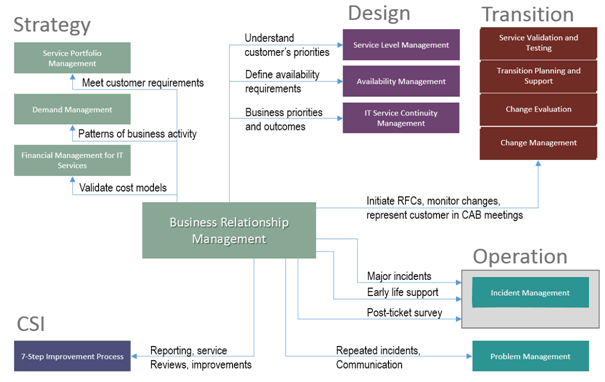We touched on the Business Relationship Management (BR Management) process briefly in my last post. Because we said that this process is so important for the mutual understanding of the Business and the IT, a few more words should be said about the interaction between it and other ITIL lifecycle processes.
To be able to meet the requirements of his/her job definition, the Business Relationship Manager (BRM) has to be involved in many of the other ITIL processes. Chapter 4.5 in the ITIL Service Strategy book describes this interaction in depth. I would like to concentrate here on a few things I find important – nothing carved in stone, just a few points of ITIL best practices I found really resonated with my practice.
So, let’s get on with it; this blog post is not going to write itself. We will do a short walkthrough of the five ITIL lifecycles:
Service Strategy
BR Management is primarily defined in the Service Strategy book. Therefore, it is inherently strongly destined to interact with its processes. For the purpose of this post, I will focus on three of them:
Service Portfolio Management – not necessarily your first choice when implementing your service management processes. Regardless of the maturity level of this process, if your BRM is serious about his job, he will spend a lot of time here. What can be done for the customer? Any new opportunities? How does it relate with what we already have for our other customers? Do we have to create new services or change the existing ones to adhere to the new requirements? Stuff like that.
Demand Management – related to the previous, the BRM will be jumping at every opportunity to support the existing or new business processes.
Financial Management for IT Services – another important, and often neglected aspect of IT service management. Your BRM will have to take care of cost and pricing models for reporting purposes, but more importantly, for evaluating investments in new opportunities.

Service Design
Service Design is tightly coupled to the strategy phase. Therefore, a few processes should be addressed. It’s mostly about the legacy Service Delivery processes:
Service Level Management (SLM) – since the BRM will mostly be performing some kind of account management or Service Level Manager function, he will be deeply involved with this process. What is the level of service the customer gets? Is it aligned with the customer priorities? Is the customer informed adequately about the KPIs and metrics? How does it relate to requirements for the new or changed services?
Availability, Capacity and IT Service Continuity Management – as we know, these processes are strongly related to the previous SLM process. The BRM will monitor the service availability, take care of communication breaches, monitor the capacity in order to comply with availability of resources, and control that the two of them comply with the service continuity according to the business continuity requirements.
Service Transition
The BRM will watch closely all activities and processes regarding his customer(s) services. His main concern will be to ensure that changes are conducted in a controlled manner, adding maximum value to the services without planned downtimes or service degradation.
Change management – Changes are usually initiated by the BRM and raised to improve the existing services, or to introduce new services that will improve the way the IT supports the business. Therefore, the BRM will often initiate Requests For Change (RFCs) in the name of the customer, and represent the customer in Change Advisory Board meetings. The BRM will closely monitor the Service Testing and Validation process, and in smaller organizations he is the perfect person for the new service testing.
Service Operation
At first glance, the Operation phase looks like a place where the BR Management is least involved. In reality, the BRM should spend a lot of time here, especially in Incident Management.
The BRM will be monitoring incidents emerging after large changes and implemented projects (early life support), he will manage complaints, post-incident surveys and compliments submitted by end users and customers. The BRM can play a significant role in keeping the customer informed about the resolution progress during Major incidents. It is essential here to define the Major incident procedure in such a way that that BRM actually helps the team instead of meddling, getting in their way and clogging the communication channels unnecessarily. Because in practice, BRMs tend to do so.
The BRM will keep an eye on the incident trends, spotting patterns of repeating or connected incidents as an entry to the Problem Management process. In my humble opinion, integration of BR Management and Problem management should definitely be further elaborated in the ITIL Service Strategy book, since it can prove to raise the customer satisfaction level significantly.
Continual Service Improvement
The BR Management process strives to improve the service and the way it supports the business. The BRM monitors various triggers and inputs generated through the previous four lifecycle stages, mainly the customer satisfaction surveys, complaints, compliments and requests. Analyzing these, new opportunities are identified and pulled through the lifecycle model, from Strategy to Operation. This cycle is highly dependent on BRM personal qualities and skills, but all mature service organizations tend to improve it by implementing best practices from the Seven-step improvement process.
Having a dedicated Business Relationship Manager for every customer is probably overkill for most IT service organizations. But, even if the provider hasn’t yet reached the maturity to implement a full BR Management process, good practices described in this ITIL process can help the account managers from the technical and sales side to turn their customer relationship into a long-lasting friendship.
To implement ISO 20000 easily and efficiently, use our ISO 20000 Documentation Toolkit that provides step-by-step guidance for full ISO 20000 compliance.

 Drago Topalovic
Drago Topalovic 


